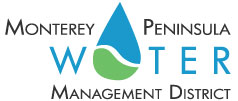One of the District’s main responsibilities is to monitor the effects of water production on the environment and work to reduce the negative impacts. In the 1980s, the District implemented several programs designed to sustain healthy riparian vegetation and a viable fishery, and to maintain the bed and banks of Carmel River. The Mitigation Program now incorporates all these activities into one plan for mitigating the adverse environmental effects of the Water Allocation Program.
In April 1990, the Water Allocation Program Final Environmental Impact Report (EIR) was prepared for the Monterey Peninsula Water Management District (MPWMD) by Mintier and Associates. The Final EIR analyzed the effects of five levels of annual Cal-Am production, ranging from 16,744 acre-feet per annum (AFA) to 20,500 AFA. On November 5, 1990, the MPWMD Board certified the Final EIR, adopted findings, and passed a resolution that set Option V as the new water allocation limit. Option V resulted in an annual limit of 16,744 acre-feet (AF) for California-American Water Company (Cal-Am) production, and 3,137 AF for non-Cal-Am production, resulting in a total allocation of 19,881 AFA for the water resource system.
Even though Option V was the least damaging alternative of the five options analyzed in the Water Allocation EIR, production at this level still resulted in significant, adverse environmental impacts that must be mitigated. Thus, the findings adopted by the Board included a “Five-Year Mitigation Program for Option V” and several general mitigation measures.
The Five-Year Mitigation Program formally began in July 1991 with the new fiscal year (FY) and was slated to run until June 30, 1996. Following public hearings in May 1996 and District Board review of draft reports through September 1996, the Five-Year Evaluation Report for the 1991-1996 comprehensive program as well as an Implementation Plan for FY 1997 through FY 2001 were finalized in October 1996. In its July 1995 Order WR 95-10, the State Water Resources Control Board directed Cal-Am to carry out any aspect of the Five-Year Mitigation Program that the District does not continue after June 1996.
At their May 3, 2004 meeting, the MPWMD Board of Directors reaffirmed MPWMD’s commitment to the Mitigation Program by passing Resolution 2004-03, which states that the District will continue the mitigation program. The program presently accounts for a significant portion of the District budget in terms of revenue (derived primarily from the MPWMD fee on the Cal-Am bill) and expenditures.
The Mitigation Program focuses on potential impacts related to fisheries, riparian vegetation and wildlife, and the Carmel River Lagoon and includes special status species and aesthetics. Activities required to avoid or substantially reduce negative impacts to the environment include: irrigation and erosion prevention programs; fishery enhancement programs; establishing flow releases from the existing dams to protect the fish and riparian habitat; monitoring and managing groundwater supplies in Carmel Valley and in the Seaside Groundwater Basin; monitoring surface and groundwater water quality; reducing municipal water demand through water conservation; and regulating activities within the Carmel River riparian corridor.
Annual Reports
Since 1991, the Monterey Peninsula Water Management District (MPWMD) has carried out a comprehensive Mitigation Program that addresses the environmental impacts of providing water to the community from the Carmel River and Seaside Groundwater Basins. The program focuses on baseline hydrologic and water quality information, the Carmel River steelhead fish population, the Carmel River riparian habitat, and the Carmel River Lagoon. The Mitigation Program is a required component of the MPWMD Water Allocation Program Environmental Impact Report that was certified by the District Board in November 1990. Each year, a detailed Annual Report is prepared that describes the District’s specific mitigation activities, data collected, and results. In addition, observed trends and conclusions are presented.
Links to the Executive Summaries of the Annual Reports for Reporting Years 2001 through 2006 are provided below. Reporting Years cover the period from July 1 through June 30, and are consistent with the District’s Fiscal Years. One exception is water production data, which are reported by Water Year (October 1 through September 30). A link to the complete reports for Reporting Year 2006 through 2011, are also provided below.
- 2021-2022 Annual Report (complete report)
- 2020-2021 Annual Report (complete report)
- 2019-2020 Annual Report (complete report)
- 2018-2019 Annual Report (complete report)
- 2017-2018 Annual Report (complete report)
- 2016-2017 Annual Report (complete report)
- 2015-2016 Annual Report (complete report)
- 2014-2015 Annual Report (complete report)
- 2013-2014 Annual Report (complete report)
- 2012-2013 Annual Report (complete report)
- 2011-2012 Annual Report (complete report)
- 2010-2011 Annual Report (complete report)
- 2009-2010 Annual Report (complete report)
- 2008-2009 Annual Report (complete report)
- 2007-2008 Annual Report (complete report)
- 2006-2007 Annual Report (complete report)
- 2005-2006 Annual Report (complete report)
- Executive Summary for Reporting Year 2005-2006
- Executive Summary for Reporting Year 2004-2005
- Executive Summary for Reporting Year 2003-2004
- Executive Summary for Reporting Year 2002-2003
- Executive Summary for Reporting Year 2001-2002
- Executive Summary for Reporting Year 2000-2001
- FINAL MONTEREY PENINSULA WATER MANAGEMENT DISTRICT IMPLEMENTATION PLAN FOR MITIGATION PROGRAM — FISCAL YEARS 1997-2001
